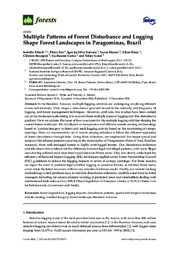Multiple patterns of forest disturbance and logging shape forest landscapes in Paragominas, Brazil.
Multiple patterns of forest disturbance and logging shape forest landscapes in Paragominas, Brazil.
Author(s): TRITSCH, I.; SIST, P.; NARVAES, I. da S.; FREITAS, L. J. M. de; BLANC, L.; BOURGOIN, C.; CORNU, G.; GOND, V.
Summary: In the Brazilian Amazon, multiple logging activities are undergoing, involving different actors and interests. They shape a disturbance gradient bound to the intensity and frequency of logging, and forest management techniques. However, until now, few studies have been carried out at the landscape scale taking into account these multiple types of logging and this disturbance gradient. Here we address this issue of how to account for the multiple logging activities shaping the current forest landscape. We developed an inexpensive and efficient remote sensing methodology based on Landsat imagery to detect and track logging activity based on the monitoring of canopy openings. Then, we implemented a set of remote sensing indicators to follow the different trajectories of forest disturbance through time. Using these indicators, we emphasized five major spatial and temporal disturbance patterns occurring in the municipality of Paragominas (State of Pará, Brazilian Amazon), from well-managed forests to highly over-logged forests. Our disturbance indicators provide observable evidence for the difference between legal and illegal patterns, with some illegal areas having suffered more than three explorations in fifteen years. They also clearly underlined the efficiency of Reduced Impact Logging (RIL) techniques applied under Forest Stewardship Council (FSC) guidelines to reduce the logging impacts in terms of canopy openings. For these reasons, we argue the need to promote legal certified logging to conserve forests, as without them, many actors mine the forest resources without any concerns for future stocks. Finally, our remote tracking methodology, which produces easy to interpret disturbance indicators, could be a real boon to forest managers, including for conservationists working in protected areas and stakeholders dealing with international trade rules such as RBUE (Wood regulation of European Union) or FLEGT (Forest Law for Enforcement, Governance and Trade).
Publication year: 2016
Types of publication: Journal article
Unit: Embrapa Eastern Amazon
Observation
Some of Embrapa's publications are published as ePub files. To read them, use or download one of the following free software options to your computer or mobile device. Android: Google Play Books; IOS: iBooks; Windows and Linux: Calibre.
Access other publications
Access the Agricultural Research Database (BDPA) to consult Embrapa's full library collection and records.
Visit Embrapa Bookstore to purchase books and other publications sold by Embrapa.

